Rome's cat sanctuaries can be found at key historic sites.
Rome has a centuries-old tradition of caring for its stray cats, in a special bond that stretches back to ancient Roman times and continues to this day.
The historical links between Rome and its felines can be traced back to the fifth century, according to the capital's website, after carbon dating showed evidence of a cat colony at Trajan's Markets.
Cats appear in the sonnets of Trilussa and Belli, while the 20th-century Italian writer Giani Rodari in a poem described the cats of Rome as "cultured cats" that "only gather in the most celebrated places" such as the Pantheon and the Forum".
"They are poor and mangy […] But the Romans of Rome know the truth, and they love city cats very much", Rodari writes.

Today the city is home to more than 5,000 cat colonies registered with Rome health authorities, with several cat shelters located among landmark heritage sites in the capital.
The most famous cat sanctuary in Rome can be found among the ruins at the archaeological site of Largo di Torre Argentina, the site of Julius Caesar's assassination in 44 BC.
The shelter, open to visitors daily between midday and 16.30, offers a long-distance adoption scheme that allows people to "adopt" cats in exchange for a donation to help volunteers look after the animals in their care.

Rome even has a word for the volunteers, traditionally mainly women, who feed and take care of stray cats: "gattare".
The best known gattara was the Oscar-winning Rome actress Anna Magnani who regularly fed the cats of Largo Argentina.
Rome recently granted protected status to the Colonia Felina di Torre Argentina as well as another well-known cat sanctuary on the grounds of the Pyramid of Cestius in the Testaccio district.
Festa del Gatto
Italy marks the national "Festa del Gatto" every year on 17 February, while the international day in celebration of cats is held annually on 8 August.


















